Every artist dreams of leaving their unique mark, but few get to literally invent a job that didn't exist before. My journey to becoming Europe's first coffee portrait artist is a testament to the unexpected power of combining passion, persistence, and a dash of daring. It's a story of carving out a novel niche and creating an entirely new form of entertainment that captivated audiences and, ultimately, sparked a global trend.
The catalyst for this extraordinary path came from an intriguing query by Nescafe Dolce Gusto. They had observed an innovative artist named Michael Brech captivating audiences with coffee portraits in his New York coffee shop in Manhattan. Nescafe Dolce Gusto wanted to replicate this magic in Europe. My immediate thought was to connect with Michael, but his focus was squarely on the Pacific, leaving the European landscape wide open. This was my moment: an invitation to step into a void, to create a new act where there was none.
This wasn't simply a matter of drawing; it demanded a deep immersion into the art and science of coffee making. I researched tirelessly, trained relentlessly in the intricate techniques of crafting microfoam, and delved into every aspect of coffee artistry. While this might seem like a leap, my background provided a surprising foundation. I had spent time working in a hotel bar in Italy after finishing my degree, gaining practical barista experience. Furthermore, for several years, I had extensively demonstrated Krups coffee machines for John Lewis, each time undergoing rigorous training at head office with coffee experts. This blend of hands-on bar experience and technical understanding of coffee mechanics, combined with my existing illustration skills, proved invaluable. It laid the groundwork for a fusion of disciplines that would birth a truly novel art form.
What followed was nothing short of an explosion. Nescafe Dolce Gusto loved what I did, and I was soon embarked on a massive roadshow, travelling up and down the country for over nine months. The sheer novelty of seeing a portrait emerge from coffee, right before their eyes, was incredibly powerful. My work garnered huge amounts of PR. I was asked to draw the iconic panel of Britain's Got Talent, including Ant and Dec. My coffee portraits were shared widely by celebrities like Piers Morgan, and the phenomenon truly took off. I found myself drawing everyone from Her Majesty The Queen to the global sensation One Direction and beloved characters from Game of Thrones.
The recognition continued to grow. I was hired by Fashion Week at Somerset House to draw VIPs, working with personalities like Oliver Proudlock from Made in Chelsea, and numerous other celebrities. I became the face of Dolce Gusto's press releases in London, meeting and connecting with an incredible network of editors, journalists, writers, and bloggers. This period was pivotal; it didn't just showcase a unique skill – it launched my career onto a completely new trajectory, building an invaluable network and cementing my reputation for innovative, live drawing.
Since those groundbreaking nine months, the trend of coffee portraiture has indeed exploded, being copied and adapted by artists across the world. My experience perfectly illustrates how potent the lure of 'novelty' is to the human spirit. It demonstrates that by identifying an unmet need, combining diverse skills, embracing rigorous training, and having the courage to pioneer a new way of doing things, you can not only create a job for yourself but also inspire an entirely new artistic movement. It’s a powerful reminder that sometimes, the greatest opportunities lie in the spaces that don’t yet exist.


The Accidental Pioneer: How I Brewed a New Niche as Europe's First Coffee Portrait Artist
The Birth of a New Art Form; The Science of 'New'
Here are three compelling insights on the power of novelty in sparking trends and gaining attention: July 2025
1. The Brain's Craving for Novelty:
Humans are hardwired to seek new experiences. Our brains release dopamine—a "feel-good" neurotransmitter—when encountering novel stimuli, creating a sense of pleasure and excitement. This inherent drive for "newness" isn't just a quirk; it's an evolutionary adaptation that once aided survival by directing attention to unfamiliar, potentially important, information. For artists and innovators, understanding this deep-seated craving is key to capturing immediate interest.
Source: Durmonski.com - Novelty-Seeking Behavior - The Main Reason You Are Easily Bored
2. Novelty as an Engine for Interest (Not Just Liking):
Research shows that simply labeling something "new" can significantly increase consumer interest and engagement. This "novelty effect" drives initial attention and exploration, even before deeper liking or emotional connection is formed. While a novel product might not immediately evoke strong affection, its newness acts as a powerful trigger for curiosity, making consumers more likely to investigate and interact. This initial pull is crucial for gaining adoption in a crowded market.
Source: ResearchGate - How can the word “NEW” evoke consumers' experiences of novelty and interest?
3. Balancing Novelty with Familiarity for Broad Adoption:
While novelty grabs attention, sustainable trends often strike a delicate balance between the new and the familiar. Products or services that are too radical might face initial resistance. The most successful innovations often introduce something novel within a recognizable framework. This mix helps early adopters embrace the new while gradually bringing in a wider, more pragmatic audience, ensuring longevity beyond the initial "newness effect."
Source: IESE Insight - Mix novelty and familiarity to move from niche to mainstream
Artistry
Capturing moments in vibrant art at events.
Illustration
Creativity
hello@sonyaparra.com
+44 7495 985 164
© 2025. All rights reserved.
